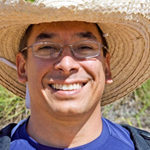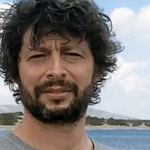Igarapé do Daracua, the small forest stream of Rio Negro river, near Barcelos, Brazil
1st place in Biotope Aquarium Design Contest 2017
![]() Croatia. Stjepan Erdeljic
Croatia. Stjepan Erdeljic
Volume: 160 L
Dimensions: 100x40x40 cm
List of fishes: Hemigrammus Bleheri, Paracheirodon Axelrodi, Apistogramma Mendezi, Prionobrama Filigera
List of plants: N/A
Description of decorations: The main large roots and branches I used were washed ashore by the nearby river. Small roots are the willow roots which were extracted from the water of the nearby lake. I used the willow roots in my previous biotope setups and it proved to be a good choice because after the formation of the biotope such small roots are sustained in the aquarium for about five months, after which they gradually begin to decompose and disappear. The majority of leaves are oak leaves with a few cherry leaves (added solely for the purpose of decoration). The substrate is made of larger stones, placed at the bottom, and sand which forms the surface layer.
Description of equipment: External filter Haqos expro 1200, 1000 lph, Flourescent lamps 2x18W, T8, 4000K
Water parameters: Temperature is 25°C, ph is 6, kh is 2
Description of the area surrounding the biotope: Rio Negro is the second largest river in South America with many river tributaries that eventually end up with smaller forest streams. One of these forest streams is Igarapé do Daracua in Brazil and is named after the village of Daracua, which is located near Barcelos.
Village Daracua is located in an inaccessible place in the depths of the Amazon rainforest, and it is easiest to get to it by boat.
Description of the underwater landscape of the biotope: During the rainy season the water level rises and is poured into the surrounding forest. This is a time of abundance, because the fish migrate into the submerged forest where abundant food sources are found and the breeding begins. Forests represent a major source of plankton and other natural foods necessary for young fish, as well as for adult ones. Other than providing natural food for fish, forests provide them with the shelter from predators and create the shadow above water, thereby preventing overheating and even excessive drying during the dry season. The soil is sandy and with almost no mineral content. A large amount of leaf litter forms a dense carpet, along with the roots of the flooded forest and branches. Water carries a large amount of detritus. Detritus contains decomposing organic matter, including animal remains, plant residues, waste products, and bacteria and other microorganisms associated with them.
Description of the parameters of the habitat: During the rainy season (starts September 6 and lasts for 8.7 months, ending around May 29) the water is considerably colder and temperature is about 23 °C, water pH is about 6ph. During the dry season (starts around May 29 and lasts for 3.2 months, ending around September 6), the water level is reduced and warmer, the temperature of water is around 28-30 °C. Due to the low water level and the large amount of leaves and branches, the water contains a large concentration of tannins, which adds a dark color like “Tea color” and the water pH is low and is about 3.5-4ph.
List of fishes: Crenuchus spilurus, Nanostomus eques, Poecilocharax weitzmani, Liosomadoras oncinus, Dicrossus filamentosus, Crenicichla notophthalmus, Mesonauta festivus, Acarichthys heckelii, Crenicichla marmorata, Heros notatus.
List of plants: At the location of the biotope I have described there are no water plants, except the forest flooded plants. The water plants that can be found in the nearby area are Echinodorus horizontalis, Echinodorus tenellus, Eleocharis sp.
Threats to the ecology: The logging of the Amazon rainforest presents a serious threat to the natural habitat of this biotope. The Amazon rainforest, besides having a great impact on the biotope , which I mentioned above, also has an impact on the overall climate of the Earth, which is why the Amazon is called the “Lungs of the World”.
Sources of information:
- http://www.tfhmagazine.com/
details/articles/fishing-with- the-piabeiros-of-brazils-rio- negro-full-article.htm - http://www.reef2rainforest.
com/2017/01/09/biotope-video- blackwater-shallows-in-the- middle-rio-negro/ - http://www.seriouslyfish.com/
species/apistogramma-mendezi/ - https://weatherspark.com/y/
28529/Average-Weather-in- Barcelos-Brazil-Year-Round
Comments of the members of the jury of Biotope Aquarium Design Contest 2017

When I first saw this aquarium I thought it was bigger than 240 litres and I absolutely believe that this tank is the job of a water glass. Perspective, gold ratio, wow factor, each method is applied correctly. Despite the great depth and visibility of the reservoir, the design and layout of the aquarium was removed from the environment. The fact that the tree branches did not come up to the surface of the water was one of the reasons that disrupting the nature. I wish the water would be a little yellowish. I particularly liked the subdivision of this aquarium. The volume is suitable for species; the fish combination is harmonious with the aquarium. Despite a few shortcomings, it is still very successful. It is one of the best works visually in the competition. Good work, congratulations.

In terms of design, if water was 5-10 cm lower, it would be a perfect biotope. I can’t see in nature so many sticks on such small space going vertically and ending in the middle of water. I also suggest using different type of leaves like small magnolia leaves or similar shaped leaf decoration.
In terms of the amount of details and aesthetic composition (“aquascaping”) this tank is probably perfect. However, I’m not sure if in the nature so many dead roots would go up. If all the roots pointing upwards would be placed in the correct direction, I mean downward, this tank would be probably my #1 (or somewhere among first three places).

It is another aquarium, which is actually smaller than it seems. It shows harsh everyday life of the flooded bushes. Neon tetras like such places.

This has to be one of the best biotope aquarium setups I have ever seen. It is hard to find the correct words to describe how good it is; I will try my best. Wow, I have been sitting, watching the aquarium video and images for over 10 minutes and I do not know where to start… Natural, an exact replica of so many streams I have swam in the Amazon. That’s it, it’s incredibly perfect! Congrats Stjepan Erdeljic.

This work really captures the wild and woolly look of the authentic biotope that inspired it. There is a great sense of depth and texture. The detailing of roots interspersed with fine fibrous debris gives the impression of fine, perhaps still-growing root hairs. All the inhabitants seem at ease. My one criticism would be that it should be a bit dirtier – with a biofilm on the roots and leaves.

I appreciate new ideas. Sometimes new is born from the fusion of several known things. Often this leads to a brilliant result. In this aquarium there are clearly traced scape techniques, but with the use of characteristic elements for the biotope aquarium design. I put the highest mark to this work. It looks somehow manmade, but only on a general picture. In detail, this is a real biotope. The author paid special attention to small things and they make the atmosphere of this aquarium. Numerous small roots are an important element of the composition. I cannot wait to use such roots in some of my aquaria!
